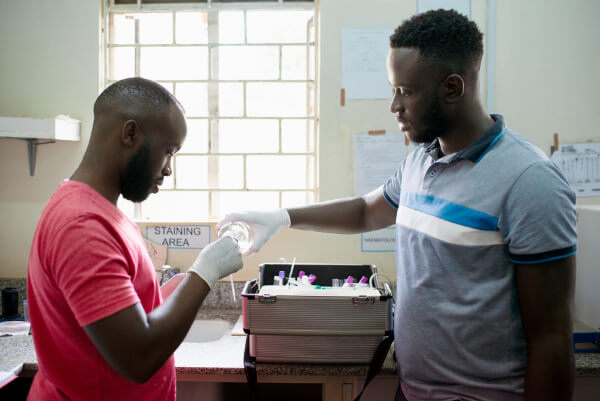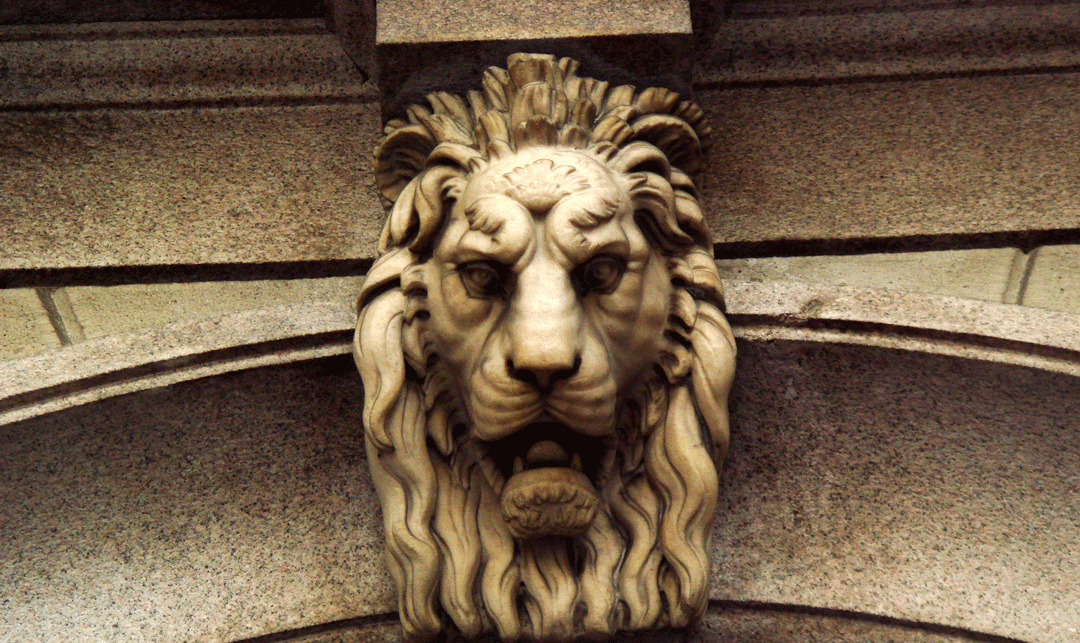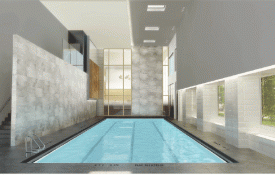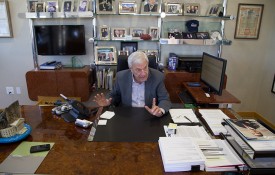Richard Meier built the lion’s share of his reputation in New York and various spots on the map east of the Rockies and around the world. He’s responsible for the Jubilee Church in Rome, the Barcelona Museum of Contemporary Art and he recently completed Meier on Rothschild, a 42-story, ultra-luxury residential tower in Tel Aviv. But of all his creations, there is one structure that has elevated Meier’s name to the pinnacle of his craft: The Getty Center in Los Angeles.
When Meier was an architecture student at Cornell, Frank Lloyd Wright visited the campus for a series of talks. “Certainly a major influence of mine at the time,” Meier confirms. “I didn’t exactly meet him, but I was in the same room with him.”

Meier and his three Associate Partners (L to R) Bernhard Karpf, Dukho Yeon, and Reynolds Logan
Photo: Silja Magg
Perhaps they brushed shoulders, because something clearly rubbed off on the budding design pupil. After graduating in 1957, Meier worked briefly with Skidmore, Owings, and Merrill (SOM; builders of several of the tallest buildings in the world), and then spent three years with Marcel Breuer (architect/designer credited with developing the first bent tubular steel chair, which became known as the Wassily chair). When he formed Richard Meier & Partners Architects, the 29-year-old New Yorker’s first office was his studio apartment. Within a year, he received the commission to design the Smith House in Connecticut, and Meier was on his way to propagating his prolific vision. Informed and inspired by the masters—Le Corbusier, Louis Kahn, Alvar Aalto, and, of course, Frank Lloyd Wright—his structures were studies of monolithic grandiosity: edifices of calm strength so well conceived, so stalwart, and so white.
Meier’s artisanal investment throughout his career has been that of deepening his understanding, appreciation, and singular focus on the relationship between structure and design in the absence of color. In his acceptance speech for the Pritzker Architecture Prize (which he received in 1984), Meier poetically remarked, “The whiteness of white is never just white. It is almost always transformed by light and that which is changing: the sky, the clouds, the sun, and the moon.”
Anyone who has been to The Getty Center more than once can appreciate how the atmospheric variations can inspire both subtle and dramatic effects as the day grows long.
“The relationship between interior and exterior space is really important. The way you go from gallery to garden, I think, is very special in Los Angeles.”
By the end of the 1960s, Meier had become associated with a group of architects known as The New York Five. Aligned with the modernist movement that drew its inspiration from the early 20th-century works of Le Corbusier, their ranks included Peter Eisenman, Michael Graves, Charles Gwathmey, John Hejduk, and Meier. “We were all friends. Some of us worked together at different times at different places,” recalls Meier. “Our early careers were intertwined in many different ways.”
“Five Architects,” the definitive version of which was published by Oxford University Press in 1975, offers a study of the quintet’s varied yet unified styles. Graves would soon defect to join the postmodernism camp, exemplifying the “whites vs. grays” debate that arose in the mid-1970s pitting modernists, who favored true use of material and no ornamentation, against postmodernists, who believed architecture should embody free expression of form, technique, and stylistic reference.
Meier, of course, stayed the modernist course and added his definitive footprints along the way. A year after completing another grand institution – the High Museum in Atlanta – the 49-year-old New Jersey native accepted the Pritzker Prize, thus becoming the youngest recipient of his industry’s highest honor. Up to that point, Meier’s firm had broken ground extensively in New York City and the East Coast as well as the Midwest, Southwest, and even Germany; but never in California, let alone Los Angeles. That was about to change.
In 1986, Meier completed a site study for a proposed multi-use arts institute that would sit above the 405 on a generous parcel of land owned by the J. Paul Getty Trust. A public destination, the facility would house a Museum, Research Institute, Conservation Institute, and Foundation. “There were a lot of challenging aspects,” Meier recalls. “Just dealing with that hilltop area and figuring out how we’re going to get people from the bottom to the top” was one logistical puzzle to be solved.

The Getty
Another aspect of import that Meier contemplated for his first West Coast project was accentuating the transition from indoors to outdoors. “The relationship between interior and exterior space is really important,” says Meier, referring to the hospitable Southern California climate. “The way you go from gallery to garden, I think, is very special in Los Angeles.”
As work on the Getty Center progressed, Meier found it practical to move to LA. Once here, he took on another endeavor, The Museum of Television & Radio (since renamed The Paley Center for Media) in Beverly Hills, which was completed in 1996. The Paley incorporated Meier’s stylistic stamp, but to the scale of the surrounding buildings. “I look very carefully at what exists in the context,” says Meier, adding that conceptual design is his favorite phase of a project. Always thinking about what can be done to enliven a space and enrich its interaction with its environment, for the Getty’s exterior surface materials Meier incorporated enameled metal and rough-cut travertine marble that would capture the light in the fossils and pock marks.
When The Getty Center opened to the public in 1997, it was a pristine and impressive sight worthy of note. Yet not everyone was unconditionally singing its praises. LA Times Art Critic Christopher Knight called The Getty a “spectacular sight” but lamented its location as being separated from “the fabric of the city.” Architecture Critic Leon Whiteson was more blunt, faulting its “tremendous blandness,” comparing the structure to “a medical research institution, probably for brain transplants or something sinister.” But the detractors were drowned out by the steady flow of people drawn to the Center’s open and well-manicured public areas, creative programming, and sprawling vistas not seen anywhere else in the city.
That same year, Meier was bestowed another honor, the American Institute of Architects Gold Medal. To this day, The Getty remains his most celebrated work. In 2004, Meier moved back to New York City after 10 years in Westwood. He went on to collaborate on a proposed structure at the former site of the World Trade Center with Peter Eisenman and Charles Gwathmey – two of his New York Five colleagues. The winning bid, however, ended up going to SOM, the firm where Meier got his first job out of college.
Over the years, Meier has designed furniture and shown his collages and drawings for various exhibits. He used to get to LA “every two weeks” or so, but his travel schedule has eased up in recent years. However, the occasion of 50 years in business brings with it a few celebratory obligations, and Meier will participate in a one-day symposium at The Getty in May.
While Meier will turn 79 in October, Richard Meier & Partners is currently developing projects in 11 new countries, including China, Israel, Turkey, Brazil, South Korea and Mexico. Clearly, there is still work to be done, and Meier has no plans to leave the helm anytime soon.












































